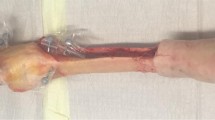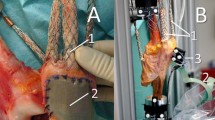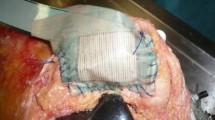Abstract
Purpose
The purpose of this study was to test the hypothesis that overstuffing the patellofemoral joint during total knee arthroplasty (TKA) would decrease passive knee flexion and alter patellar kinematics during knee flexion.
Methods
Ten cadaveric knees were implanted with cruciate-retaining TKAs, and the patellofemoral joint was overstuffed in 2-mm increments with custom-augmented patellar prostheses (+2 mm through +8 mm). Changes to knee flexion, patellar shift, tilt and rotation were measured with an imageless optical-tracking computer navigation system.
Results
Knee flexion decreased an average 1.2° with each additional 2 mm of patellar thickness. Compared with control TKA (+0 mm), no significant decrease in knee flexion was detected until the patellofemoral joint was overstuffed with the +8-mm patellar prosthesis. Kinematic tracking data showed significantly greater lateral shift of patella with the +6- and +8-mm prostheses and significantly greater lateral tilt with the +8-mm prosthesis. Overstuffing had no appreciable effect on patellar rotation.
Conclusions
Passive knee flexion after TKA is significantly reduced when overstuffing the patellofemoral joint by +8 mm, and patellofemoral kinematics are altered when overstuffing the joint by +6 mm. These results demonstrate the relatively modest effects of patellofemoral overstuffing on knee flexion and patellar tracking kinematics after TKA.





Similar content being viewed by others
References
Bengs BC, Scott RD (2006) The effect of patellar thickness on intraoperative knee flexion and patellar tracking in total knee arthroplasty. J Arthroplasty 21(5):650–655
Mihalko W, Fishkin Z, Krackow K (2006) Patellofemoral overstuff and its relationship to flexion after total knee arthroplasty. Clin Orthop Relat Res 449:283–287
Hsu HC, Luo ZP, Rand JA, An KN (1996) Influence of patellar thickness on patellar tracking and patellofemoral contact characteristics after total knee arthroplasty. J Arthroplasty 11(1):69–80
Merican AM, Ghosh KM, Baena FR, Deehan DJ, Amis AA (2012) Patellar thickness and lateral retinacular release affects patellofemoral kinematics in total knee arthroplasty. Knee Surg Sports Traumatol Arthrosc
Youm YS, Cho WS, Woo JH, Kim BK (2010) The effect of patellar thickness changes on patellar tilt in total knee arthroplasty. Knee Surg Sports Traumatol Arthrosc 18(7):923–927
Daniilidis K, Vogt B, Gosheger G, Henrichs M, Dieckmann R, Schulz D, Hoell S (2012) Patellar resurfacing as a second stage procedure for persistent anterior knee pain after primary total knee arthroplasty. Int Orthop 36(6):1181–1183
Petersen W, Rembitzki IV, Bruggemann GP, Ellermann A, Best R, Koppenburg AG, Liebau C (2014) Anterior knee pain after total knee arthroplasty: a narrative review. Int Orthop 38(2):319–328
Indelli PF, Marcucci M, Pipino G, Charlton S, Carulli C, Innocenti M (2014) The effects of femoral component design on the patello-femoral joint in a PS total knee arthroplasty. Arch Orthop Trauma Surg 134(1):59–64
Cheng T, Zhao S, Peng X, Zhang X (2012) Does computer-assisted surgery improve postoperative leg alignment and implant positioning following total knee arthroplasty? A meta-analysis of randomized controlled trials? Knee Surg Sports Traumatol Arthrosc 20(7):1307–1322
Dorr LD, Malik A, Wan Z, Long WT, Harris M (2007) Precision and bias of imageless computer navigation and surgeon estimates for acetabular component position. Clin Orthop Relat Res 465:92–99
Fu Y, Wang M, Liu Y, Fu Q (2012) Alignment outcomes in navigated total knee arthroplasty: a meta-analysis. Knee Surg Sports Traumatol Arthrosc 20(6):1075–1082
Heinert G, Kendoff D, Preiss S, Gehrke T, Sussmann P (2010) Patellofemoral kinematics in mobile-bearing and fixed-bearing posterior stabilised total knee replacements: a cadaveric study. Knee Surg Sports Traumatol Arthrosc 19(6):967–972
Plate JF, Seyler TM, Halvorson JJ, Santago AC, 2nd, Lang JE (2013) Non-anatomical capsular closure of a standard parapatellar knee arthrotomy leads to patellar maltracking and decreased range of motion: a cadaver study. Knee surgery, sports traumatology, arthroscopy: official journal of the ESSKA
Dhollander AA, Bassens D, Victor J, Verdonk P (2013) Patellar tilt and thickness do not influence postoperative flexion in a high-flex design total knee arthroplasty. Knee Surg Sports Traumatol Arthrosc 21(12):2817–2822
Pierson JL, Ritter MA, Keating EM, Faris PM, Meding JB, Berend ME, Davis KE (2007) The effect of stuffing the patellofemoral compartment on the outcome of total knee arthroplasty. J Bone Joint Surg Am 89(10):2195–2203
Ritter MA, Pierce MJ, Zhou H, Meding JB, Faris PM, Keating EM (1999) Patellar complications (total knee arthroplasty). Effect of lateral release and thickness. Clin Orthop Relat Res 367:149–157
Lee DH, Park JH, Song DI, Padhy D, Jeong WK, Han SB (2010) Accuracy of soft tissue balancing in TKA: comparison between navigation-assisted gap balancing and conventional measured resection. Knee Surg Sports Traumatol Arthrosc 18(3):381–387
Pitto RP, Graydon AJ, Bradley L, Malak SF, Walker CG, Anderson IA (2006) Accuracy of a computer-assisted navigation system for total knee replacement. J Bone Joint Surg 88(5):601–605
Biedert RM, Gruhl C (1997) Axial computed tomography of the patellofemoral joint with and without quadriceps contraction. Arch Orthop Trauma Surg 116(1–2):77–82
Salsich GB, Perman WH (2007) Patellofemoral joint contact area is influenced by tibiofemoral rotation alignment in individuals who have patellofemoral pain. J Orthop Sports Phys Ther 37(9):521–528
Amis AA, Senavongse W, Bull AMJ (2006) Patellofemoral kinematics during knee flexion-extension: An in vitro study. J Orthop Res 24(12):2201–2211
Chew JT, Stewart NJ, Hanssen AD, Luo ZP, Rand JA, An KN (1997) Differences in patellar tracking and knee kinematics among three different total knee designs. Clin Orthop Relat Res 345:87–98
Katchburian MV, Bull AMJ, Shih Y-F, Heatley FW, Amis AA (2003) Measurement of patellar tracking: assessment and analysis of the literature. Clin Orthop Relat Res 412:241–259
Stoddard JE, Deehan DJ, Bull AMJ, McCaskie AW, Amis AA (2013) No difference in patellar tracking between symmetrical and asymmetrical femoral component designs in TKA. Knee surgery, sports traumatology, arthroscopy: official journal of the ESSKA
Ghosh KM, Merican AM, Iranpour F, Deehan DJ, Amis AA (2009) The effect of overstuffing the patellofemoral joint on the extensor retinaculum of the knee. Knee Surg Sports Traumatol Arthrosc 17(10):1211–1216
Acknowledgments
We recognise the following parties for their valuable contribution towards completion of this work: Depuy Orthopaedics provided prosthetic components and financial support, Brainlab provided the software required to run our navigation system, and Richard D. Scott, MD, provided the custom augmented patellar buttons and guidance during study design.
Author information
Authors and Affiliations
Corresponding author
Rights and permissions
About this article
Cite this article
Bracey, D.N., Brown, M.L., Beard, H.R. et al. Effects of patellofemoral overstuffing on knee flexion and patellar kinematics following total knee arthroplasty: a cadaveric study. International Orthopaedics (SICOT) 39, 1715–1722 (2015). https://doi.org/10.1007/s00264-015-2715-9
Received:
Accepted:
Published:
Issue Date:
DOI: https://doi.org/10.1007/s00264-015-2715-9




